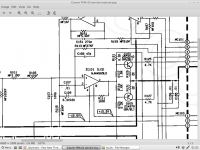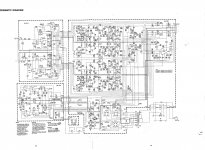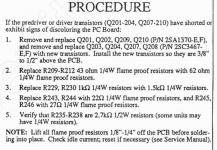Is the NJM4580L a suitable replacement for a NJM4565L? To my untrained eye the datasheets look similar.
Datasheets
http://www.njr.com/semicon/PDF/NJM4565_E.pdf
http://www.mouser.com/ds/2/294/NJM4580_E-218114.pdf
Thanks
Datasheets
http://www.njr.com/semicon/PDF/NJM4565_E.pdf
http://www.mouser.com/ds/2/294/NJM4580_E-218114.pdf
Thanks
Attachments
Both those IC's are totally outclassed by the latest offerings and tbh, I wouldn't use either nowadaysbutthis is one application where any substitution should be checked carefully in use. The original has the dubious claim to be able to drive 400 ohm loads but that requirement doesn't seem needed here.
So as to your question, yes, its probably a suitable replacement but imo its just replacing one very average device with another of the same.
So as to your question, yes, its probably a suitable replacement but imo its just replacing one very average device with another of the same.
Absolutely. After all, stability of the whole amplifier depends on how it behaves. At least the topologies of the two are very closely related.butthis is one application where any substitution should be checked carefully in use.
The '4580 has lower noise but higher input bias current. It also is somewhat faster. NJM2068 is even lower-noise and faster still.
Unfortunately the choices among SIP form factor opamps (L) are pretty slim these days. I think the closest that Mouser stocks would be Rohm's BA4560N. NJM4556AL may also work (a little slower than the original but with plenty of output current, and again similar architecture).
All things considered, the '4580 probably isn't such a bad bet. Do use a bulb tester though, and if you can, also order one '4556AL and BA4560N in case the amp is not happy. If you don't need it, the '4556 would still be good for a cMoy...
Great advice about ordering more than just one.
I plan on ordering a NJM4580, BA4560N, and NJM4556AL. The '4580 looks like it has better Gain Bandwidth and is faster with .0005% THD, but I agree the '4556 is the closest match to original. I will try them all and see which is best.
I agree I'm replacing an average device with another average device but I am just trying to get this amp up and running for now. I was getting 1.5vdc at one of the outputs of the NJM4565L so it's toast.
The 2SA1370/2SC3467 pre-driver and drivers have blackened up the board and will also be getting replaced. I am having a hard time finding similar offerings, the ones I find have leads that are EBC (base in the middle). But on the 2SA1370/2SC3467 datasheet it says the leads are BCE (collector in middle). I plan on using the whole length of the leads leaving plenty of space between them and the PCB for heat dissipation, they are currently sitting right on top of the board which is probably why they blackened it. I did find the NTE2366/NTE399 but mouser doesn't supply it, I was trying to keep my order to just one supplier to save on shipping costs.
Thanks
2SA1370/2SC3467 datasheet: HTTP 301 This page has been moved
I plan on ordering a NJM4580, BA4560N, and NJM4556AL. The '4580 looks like it has better Gain Bandwidth and is faster with .0005% THD, but I agree the '4556 is the closest match to original. I will try them all and see which is best.
I agree I'm replacing an average device with another average device but I am just trying to get this amp up and running for now. I was getting 1.5vdc at one of the outputs of the NJM4565L so it's toast.
The 2SA1370/2SC3467 pre-driver and drivers have blackened up the board and will also be getting replaced. I am having a hard time finding similar offerings, the ones I find have leads that are EBC (base in the middle). But on the 2SA1370/2SC3467 datasheet it says the leads are BCE (collector in middle). I plan on using the whole length of the leads leaving plenty of space between them and the PCB for heat dissipation, they are currently sitting right on top of the board which is probably why they blackened it. I did find the NTE2366/NTE399 but mouser doesn't supply it, I was trying to keep my order to just one supplier to save on shipping costs.
Thanks
2SA1370/2SC3467 datasheet: HTTP 301 This page has been moved
Last edited:
This is a very unusual circuit with the upper opamps being used to sense the actual load current to the speaker, and it seems that this varying quantity is then used to modulate the input stage... perhaps an attempt at a halfway house of voltage vs current drive.
Depending on the PCB material, blackening is not unusual. Also fitting the devices close to the PCB aids heat transfer from the device junction into the surrounding area and can keep device temperature significantly lower than having the devices mounted on longer leads.
If you suspect one of the opamps has failed (and that would be extremely rare) then you could always swap it with one of the others and see if the fault transfers.
Depending on the PCB material, blackening is not unusual. Also fitting the devices close to the PCB aids heat transfer from the device junction into the surrounding area and can keep device temperature significantly lower than having the devices mounted on longer leads.
If you suspect one of the opamps has failed (and that would be extremely rare) then you could always swap it with one of the others and see if the fault transfers.
This is a very unusual circuit with the upper opamps being used to sense the actual load current to the speaker, and it seems that this varying quantity is then used to modulate the input stage... perhaps an attempt at a halfway house of voltage vs current drive.
Depending on the PCB material, blackening is not unusual. Also fitting the devices close to the PCB aids heat transfer from the device junction into the surrounding area and can keep device temperature significantly lower than having the devices mounted on longer leads.
If you suspect one of the opamps has failed (and that would be extremely rare) then you could always swap it with one of the others and see if the fault transfers.
The protection relay trips when a signal is applied to the left channel.
I am replacing the transistors due to a service bulletin I have attached. I don't think any of them have failed but the service bulletin does have you increase the emitter resistor values along with replacing the transistors, the bulletin also tells to leave a space between the transistor and board. What you have said makes sense about the board helping to dissipate heat but I guess they found it to be quite the opposite maybe? Anyway I am still looking around for my best options for replacements for these transistors.
Attachments
That is obviously a definite service bulletin to address a known issue so I guess you have to follow it. Sounds like the protection circuit is detecting the 1.5 volts as excessive (which it is... but "hard" faults usually give rail to rail offset). It might be instructive to look at the output on a scope and make sure that it is not oscillating.
Curious if you've had a chance to test the opamps yet. Any results or feedback?
I have...but only one so far. The amp is stable and I have been listening to it with the NJM4556 in there. I plan to listen to some of my usual favorite albums and then try the NJM4580 next, rinse and repeat with the other opamps. But so far I don't hear any difference compared to the original opamp which was faster and had higher gain bandwidth. The NJM4580 is faster with higher gain bandwidth than the original, maybe I will hear an improvement with that next but I doubt it.
I am also curious to see what other opamps people have tried in these amps and if they made a huge difference or not.
- Status
- Not open for further replies.
- Home
- Amplifiers
- Solid State
- NJM4565L / NJM4580L


